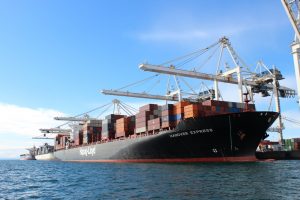The Port of Vancouver offers Canadian, North American and global businesses experience, services and choice. This dynamic gateway is part of an efficient, effective and integrated supply chain.
Principal trading economies
| Principal trading economies | million metric tonnes of cargo |
| China | 37.5 |
| Japan | 18.3 |
| Korea (South) | 14.3 |
| United States | 4.0 |
| Indonesia | 3.6 |
| India | 3.5 |
| Taiwan | 3.1 |
| Brazil | 2.6 |
| Chile | 2.2 |
| Mexico | 1.7 |
As trade through the port increases, we are increasing use of existing infrastructure and technology as well as promoting transportation alternatives such as off-docks and inland terminals. Our goal is to develop the most reliable and consistent supply chain in North America.
We’re investing heavily across our business sectors to deliver value to our customers. We’re bringing your goods closer to market, and you closer to your customers. Here’s how:
Superior infrastructure
The port is connected to every key market in North America through three Class 1 railways: CN, Canadian Pacific and BNSF and through an expansive road network.
Increased capacity
 Investments exceeding $9 billion from governments, industry and the port authority have been made on terminal and transportation infrastructure in Vancouver’s Lower Mainland to support the improved movement of goods through the Asia Pacific Gateway. These projects add road, rail and terminal capacity, enhance efficiency and reliability and support the improved movement of goods through the Asia Pacific Gateway.
Investments exceeding $9 billion from governments, industry and the port authority have been made on terminal and transportation infrastructure in Vancouver’s Lower Mainland to support the improved movement of goods through the Asia Pacific Gateway. These projects add road, rail and terminal capacity, enhance efficiency and reliability and support the improved movement of goods through the Asia Pacific Gateway.
Service choices
The world’s leading shipping lines choose the Port of Vancouver. Our port offers shippers extensive sailing options and choice of 29 terminals to meet their needs.
Modern equipment and an experienced workforce
Super Post-Panamax capacity, efficient and well-equipped terminals, as well as a highly-trained and an experienced workforce allows for goods to transit through our port quickly and safely.
Supply chain transparency
We drive transparency, efficiency and productivity throughout the supply chain by working collaboratively with terminals and rail operators on developing new measures to improve the flow of goods through the Port of Vancouver. Customers benefit by having predictability of cargo delivery through a reliable and consistent supply chain.
Breaking Bottlenecks podcast series
As Canada’s largest port, the Port of Vancouver is part of a large and intricate supply chain system. The goods that move through the port can only do so with the support of railways and roads. But when issues disrupt the flow of the supply chain system, bottlenecks arise. Learn about the work happening at the Port of Vancouver to address the various types of bottlenecks in the regional supply chain system in our new podcast series, Breaking Bottlenecks.
